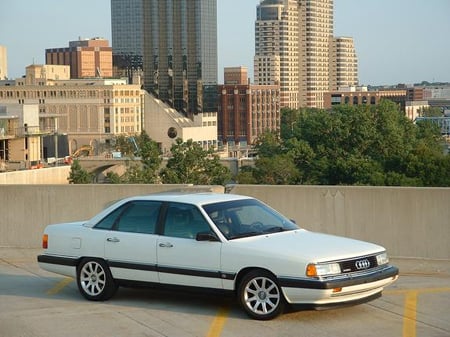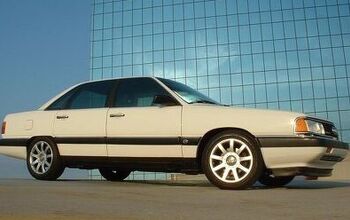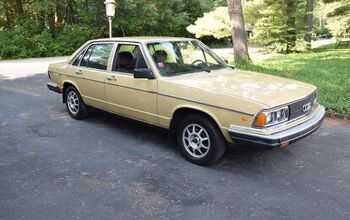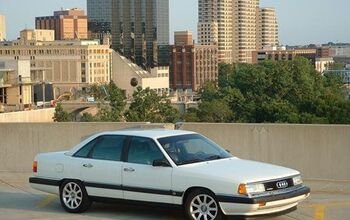In Defense of: The Audi 5000

[Update: this article has been updated and re-published here]
When I first heard about the Audi “sudden unintended acceleration” segment on CBS’s 60 Minutes in 1986, I knew immediately that they were blowing smoke. Literally.
A few years earlier, I was part of a TV crew shooting an educational program. Legendary race-car driver Parnelli Jones was the guest celebrity. The producer offered to take us to lunch in his 1976 Cadillac Fleetwood Brougham. We hopped in. Parnelli took the wheel.
Parnelli fired up the Caddy’s big V8, dropped it in gear and floored it- with his other foot on the brake. The left rear wheel lit up in a screeching howl; the car was soon engulfed in a cloud of acrid smoke. The Caddy didn’t move an inch- obviously. And neither did Parnelli, glancing at the wincing producer with his wicked grin. I had assumed (wrongly) that race-car drivers grew up eventually.
The experience seared in a lesson in basic automobile physics: brakes are always more powerful than engines, even when they have 500 cubic inches (8.2 liters). Too bad we didn’t have our cameras running. We could have made a graphic rebuttal to 60 Minutes’ fraudulent destruction of Audi.
Let’s set the scene. It’s 1984. Audi sales had shot up 48 percent on the strength of their new aero-dynamic 5000, the hot new weapon in the perpetually-escalating suburban driveway status war. It was a stunning piece. Audi was on a roll.
Suddenly, the war turned bloody. Moms in runaway Audi 5000’s were mowing down their little kids in the driveway and pinning granny against the far garage wall.
This hadn’t happened with the Olds Cutlass Supreme Coupe, the “hot” suburban car Mom traded in for her Audi. The German car certainly felt different. Unlike the Olds’ wide push-bar brake pedal– that some Americans still operated with their left feet– the Audi had that weird, small brake pedal, kinda’ close to the gas pedal.
And these Audis had a mind of their own. No matter how hard Mom pushed on the brake pedal, the Audi kept on going, right through the garage door. This despite the fact that the little five-cylinder mill only cranked out 130 horsepower. And the top-notch four-wheel disc brake system probably could generate well over 600 g-force horsepower.
Apparently, the brakes were failing at exactly the same moment that the gas pedal decided it had a mind of its own. Perfectly plausible, at least to the 60 Minutes crew.
About as plausible as ignoring the police report of the most dramatic victim on the show, Kristi Bradosky, who ran over her six year old son. That report said “Bradosky’s foot slipped off the brake pedal onto the gas pedal accelerating the auto.” Denial isn’t just a river.
Ed Bradley’s 17 minute “investigative report” aired on November 23, 1986. Between interviews of the teary-eyed “victims” (drivers) of unintended acceleration swearing their feet were on the brake pedal, CBS showed a clip of a driverless Audi lurching forward on its own.
Viewers didn’t see the canister of compressed air on the passenger-side floor with a hose running to a hole drilled in the transmission. An “expert” had rigged the Rube Goldberg device to shift the big Audi into drive and, like any automatic-equipped car, move forward (unless the brakes are depressed).
The clip was blatantly deceptive AND totally irrelevant. Nobody claimed driverless Audis were taking off and killing kids. Mom was always at the wheel, pushing the 5000’s “brake” pedal with all her might.
In 1989, after three years of studying the blatantly obvious, the National Highway Traffic Safety Administration (NHTSA) issued their report on Audi’s “sudden unintended acceleration problem.” NHTA’s findings fully exonerated Audi and some other implicated foreign makes.
The report concluded that the Audi’s pedal placement was different enough from American cars’ normal set-up (closer to each other) to cause some drivers to mistakenly press the gas instead of the brake. 60 Minutes did not retract their piece; they called the NHTSA report “an opinion.”
A flood of lawsuits was already washing over Audi, not to mention a tsunami of bad publicity. Audi took a questionable stance: they didn’t blame the drivers for the problem, even after the NHTSA report came out. Hey, the customer’s always right, and we sure wouldn’t want to make our American customers look stupid. Anything but that.
So the German automaker took it on the chin. Audi sales collapsed, from 74k units in 1984 to 12k by 1991. The timing added insult to injury; sales fell during the same years when Lexus arrived to battle for the hearts and wallets of America’s up-scale consumers. The Japanese autos quickly became the new suburban driveway prestige weapon.
Audi’s wanna-be-Lexus drivers launched a class action suit charging lost resale value. No wonder the brand almost abandoned the U.S. in 1993. It’s a killer market.

More by Paul Niedermeyer
Latest Car Reviews
Read moreLatest Product Reviews
Read moreRecent Comments
- Joe65688619 Under Ghosn they went through the same short-term bottom-line thinking that GM did in the 80s/90s, and they have not recovered say, to their heyday in the 50s and 60s in terms of market share and innovation. Poor design decisions (a CVT in their front-wheel drive "4-Door Sports Car", model overlap in a poorly performing segment (they never needed the Altima AND the Maxima...what they needed was one vehicle with different drivetrain, including hybrid, to compete with the Accord/Camry, and decontenting their vehicles: My 2012 QX56 (I know, not a Nissan, but the same holds for the Armada) had power rear windows in the cargo area that could vent, a glass hatch on the back door that could be opened separate from the whole liftgate (in such a tall vehicle, kinda essential if you have it in a garage and want to load the trunk without having to open the garage door to make room for the lift gate), a nice driver's side folding armrest, and a few other quality-of-life details absent from my 2018 QX80. In a competitive market this attention to detai is can be the differentiator that sell cars. Now they are caught in the middle of the market, competing more with Hyundai and Kia and selling discounted vehicles near the same price points, but losing money on them. They invested also invested a lot in niche platforms. The Leaf was one of the first full EVs, but never really evolved. They misjudged the market - luxury EVs are selling, small budget models not so much. Variable compression engines offering little in terms of real-world power or tech, let a lot of complexity that is leading to higher failure rates. Aside from the Z and GT-R (low volume models), not much forced induction (whether your a fan or not, look at what Honda did with the CR-V and Acura RDX - same chassis, slap a turbo on it, make it nicer inside, and now you can sell it as a semi-premium brand with higher markup). That said, I do believe they retain the technical and engineering capability to do far better. About time management realized they need to make smarter investments and understand their markets better.
- Kwik_Shift_Pro4X Off-road fluff on vehicles that should not be off road needs to die.
- Kwik_Shift_Pro4X Saw this posted on social media; “Just bought a 2023 Tundra with the 14" screen. Let my son borrow it for the afternoon, he connected his phone to listen to his iTunes.The next day my insurance company raised my rates and added my son to my policy. The email said that a private company showed that my son drove the vehicle. He already had his own vehicle that he was insuring.My insurance company demanded he give all his insurance info and some private info for proof. He declined for privacy reasons and my insurance cancelled my policy.These new vehicles with their tech are on condition that we give up our privacy to enter their world. It's not worth it people.”
- TheEndlessEnigma Poor planning here, dropping a Vinfast dealer in Pensacola FL is just not going to work. I love Pensacola and that part of the Gulf Coast, but that area is by no means an EV adoption demographic.
- Keith Most of the stanced VAGS with roof racks are nuisance drivers in my area. Very likely this one's been driven hard. And that silly roof rack is extra $'s, likely at full retail lol. Reminds me of the guys back in the late 20th century would put in their ads that the installed aftermarket stereo would be a negotiated extra. Were they going to go find and reinstall that old Delco if you didn't want the Kraco/Jenson set up they hacked in?


































Comments
Join the conversation
It is disheartening to see all the adulation on TV and in print, of Don Hewitt, mastermind of 60 Minutes, now that he has passed on, when thinking of all the negatives that resulted from the Audi 5000 debacle. He was a pioneer and did many good things for broadcasting. Too bad his ethics weren't as good. I have not watched 60 Minutes since (or many other expose programs as well).
[…] Here’s an example from a pretty typical remembrance of what happened, from a 2007 article written “in defense of Audi”: […]